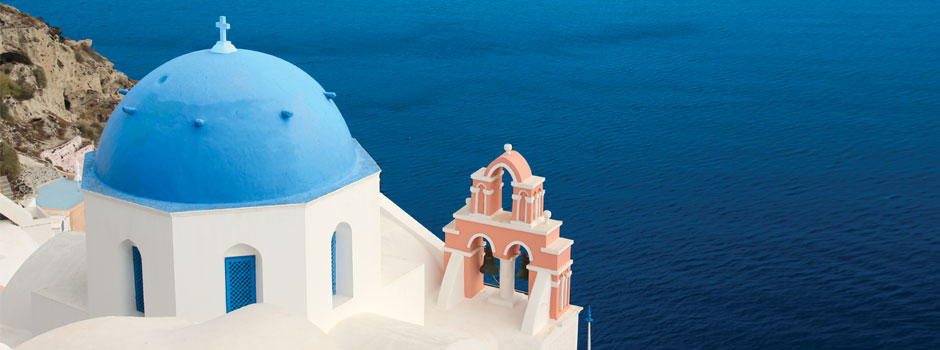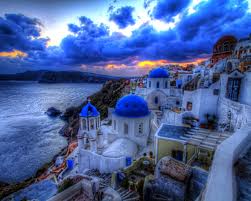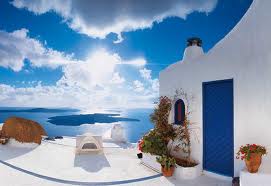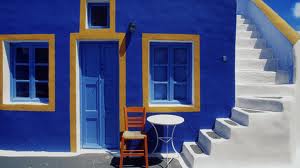
A LETTER FROM SANTORINI
Travels With The Family in Greece

By Contributing Editor Richard Bruce Turen
This is my third return to Santorini and the small village of Oia on the northern tip of a volcanic mountain. The first time I visited the island I was under the command of a rather mad sea captain who dropped anchor a few hundred meters off the shoreline to announce over the ships P.A. system that he was going to be speaking directly with Zeus. And that is precisely what he began to do. Unfortunately, Zeus never answered.
Once again, I was arriving by sea. We were quickly whisked away from the small harbor to begin the tortuous climb up the side of the 2,000 foot mountain that would lead to Thira the capital of the most distinctly beautiful island in all of Greece.
The towns and villages that line the top of the huge mountain of rock jutting out of the sea seem framed, almost embraced by their stark surroundings. There isn’t any vegetation visible until you tour the interior valleys, where some of the island’s most prized vineyards thrive. On first arrival, however, all you see are the red and brown and black striations of pumice that weave among the layers of
rock cliffs.
The Ruins of another Time
Santorini may be, according to a number of scholars, the famed lost city of Atlantis. The island was a surprisingly sophisticated outpost of Minoan civilization by about 3,000 BC.
The most important event in the island’s history was the great catastrophe of 1550 BC, give or take a few years, when the volcano erupted sending the heart of the island into the sea, and resulting in land altering earthquakes throughout the Aegean.
We were mindful of all of this as we walked through the incredible ruins at Akrotiri with the archeologist in charge of paintings on our third day on the island.
He was an unusually tall man, with an enormous Grecian nose, longish hair, and, according to the ladies in our group, the most sensuous voice they had encountered in Greece. He wore porous linen clothing and moved in a constant state of grace. He was also a tad arrogant, warning those not in our group that they were not entitled to hear his words. “You must pay for my services” he bellowed. I noticed several ladies starting to take up a collection.
As one of only five archeologists on the site, he was able to provide a personal account of the work being done at Akrotiri. This site was discovered by Santorini’ hero, Professor Marinatos, in 1967. Just imagine a hero among the young who is not a sports figure and does not play an instrument. He had been thinking of excavating in the area for more than 30 years. As a student, he had been digging at a site in Crete and noticed the presence of volcanic ash. He theorized that the ash came from a gigantic eruption on Santorini. Either that or it was an overflow from Gary, Indiana.
What resulted was one of the most important archeological finds in the ancient world. The site is covered with a sheet metal roof and chicken wire fencing leads visitors past the estimated 20% of the site that has been uncovered. Sadly, mountains of boxes filled with pieces of wall paintings and pottery, furniture and kitchen implements, line the walls on one side of Akrotiri. The government does not have enough money to send more than a handful of archeologists and a few students to work at the site.
What has been uncovered reveals an amazingly advanced civilization. The Minoans had developed a system of indoor plumbing. Windows were built into house frames and several houses of three of four bedrooms have been discovered. There was a shopping street and a number of communal kitchens. Affluent owners lived in the top floors of the buildings, while their workers slept on
The ground floor where the metal and pottery workshops and the mills were located.
Aside from the Acropolis itself, the ruins at Akrotiri may represent the most important and best preserved ancient site in Greece.
A Village at the End of the Road 
The road ends in Oia. If you go any further you drop, far below, to the sea. We stayed in two hotels, the Atlantis Villas and the Canavas. Canavas is new, built in the typical Cycladic style, with whitewashed terraces overlooking the sea and a swimming pool built into the top terrace on the hill above the rooms.
The Atlantis Villas also has its charms. One is Theresa, a mule who serves as the hotel porter carrying bags down the steep stone steps to each “cave” carved into the face of the mountain. Each of the rooms is furnished in a very traditional style with local antiques.
The setting for both hotels was absolutely spectacular. You could see nearby islands and, far below, passing ships.
Angela and I were assigned one of the darker “cave” dwellings. My father-in-law, Gus, was placed in the unit just opposite the swimming pool.
How can I describe Gus to you? Try to imagine that Anthony Quinn had been cross-bred with the energizer rabbit and you will begin to gain an understanding. Gus was an instant party. He would get up in the middle of dinner in the nicest restaurant to initiate a round of Greek dancing.
The swimming pool at the Atlantis Hotel, with its sharp drop thousands of feet below to the sea, was the placed I dreamed about when planning the trip more than a year ago. And the scene I pictured most often, was sitting by the pool reading quietly. I judge each trip by the number of pages I read in the books I always bring along. I once had a 600 page trip through the Panama Canal. This was a 0-pages trip.

Anyway, I was just settling in on my lounge chair, when Gus announced that he arranged cocktails and “snacks” at five p.m. His cocktail party, he warned us, would begin promptly and we were not to be late. Since it was too hot to move, there was no doubt we would be there.
At five minutes to five, I heard a chorus of “Oooooooopppaaaaaaahs” coming from high atop the hill where the steps begin on the road to the village.
Gus came out of his cave and returned the shout. His caravan was arriving. We sat there in amazement as a collection of young and old townspeople began climbing down the 137, steep stone steps carrying what looked like trays of food.
Gus had negotiated a cocktail hour mini-buffet. It would be my guess that he introduced himself at the local restaurant across the road as the “Mayor of Chicago”, visiting with an important group of American dignitaries.
By the look of the food, he had really spread it on thick. We were treated to Greek olives, feta
Cheese, hot Greek breads, garlic spread, roasted lamb meatballs, and platters of baked chicken.
The door of Gus’ room opened, signaling that drinks were being served. This happened each evening on Santorini. Each night the procession would arrive, like a camel caravan in the desert. We never knew how he had convinced them to bring the food. We didn’t see any exchange of money. Gus
Had decided that he was going to host this trip since he spoke fluent Greek.
Of course Gus did sometimes get a bit out of hand. On our return flight, sitting next to me, I heard him muttering that he was bored. Of course several of us were trying to sleep. A few moments later, I heard gales of laughter from the
rear of the big plane. Gus had taken his headset, converted it to a stethoscope look-alike, and was proceeding to go up and down the aisles offering free chest examinations. My new book, “Travels with Gus”, will be shortly published by Random House.
One narrow street lead from the top ledge of our hotel entrance to the village. It was lined with home-made jewelry shops owned by a collection of people from as close as Athens and as far away as Columbus, Ohio. There were art studios and enough outdoor and rooftop restaurants to happily graze for a week or so without ever going back to the same place twice.
What do you do on Santorini? Just about anything you care to do. There are wineries and monasteries, shopping in the capital, Thira. You can lie about on black sand beaches or hike the crater of a volcano. You can take ferry boats to neighboring islands and explore villages that have remained unchanged for centuries. Or, you can just relax by the pool in the heat of the mid-day sun. At night you walk, you promenade through the narrow streets, always glancing to your left, because on the way into the village you are passing the most beautiful settings in all of Greece.
And as you walk, you begin to think of tomorrow and what particular vantage point you will choose to observe the most spectacular sunsets in all of Europe, deep navel-orange bright with streaks of crimson and burgundy.

